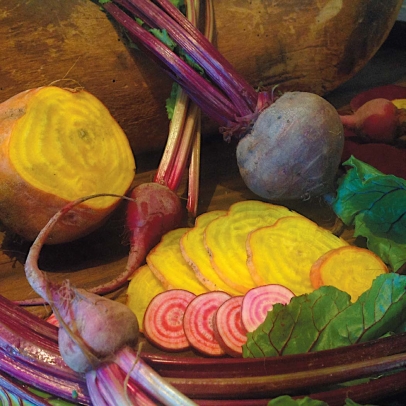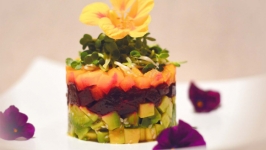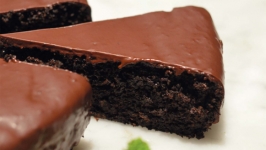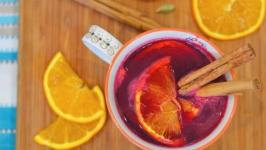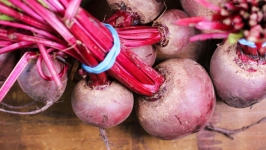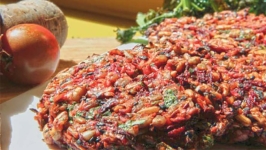Root Vegetable Can't be Beat!
Beets are the jewels of the underground garden. While their unassuming leafy greens are completely edible, what’s going on underneath is where the real action is. Beetroots, with colors ranging from red, orange and even striped, are growing beneath those greens, just waiting for the right time to be pulled, washed and eaten. Although beets are available almost year-round, the best time to take advantage of freshly harvested beets is the end of summer through autumn.
A BRIEF BEET HISTORY
Beets have an ancient history. Wild beetroot plants resembled the shape of a carrot more than the bulbous beet we know today. It has been written that the Hanging Gardens of Babylon in 800 B.C. had beetroot plants. Ancient Greeks cultivated them around 300 B.C. Although the greens were often eaten, the beetroot was used mainly for medicinal and cosmetic purposes including a dye for hair.
The beetroot that we know today was most likely developed in Italy in the third century A.D. The Italians worked on creating a hybrid of the wild beets native to the coasts of the Mediterranean. It wasn’t until the 16th century that Europeans began using beetroot for culinary purposes.
You can blame Napoleon for the expanded use of beets for sugar. Prior to 1850, most sugar came from the sugar cane plant. The substance was a hot commodity that only European high society was able to afford. Britain had a monopoly on the sugar cane trade. During the Napoleonic wars of the early 1800s, the British blocked France’s trade routes to the Caribbean, leaving the country low on sugar cane supplies
French scientists presented Napoleon with a form of sugar made from the sugar beet. Napoleon was so impressed he decreed that sugar beets should be planted throughout France. Within a few years, there were more than 40 sugar beet factories in Northern France, with additional factories in Germany, Austria and Russia. Soon the less expensive beet sugar flooded the British market, making sugar more affordable.
A COLORFUL NUTRITIOUS PALATE
Although beetroot is still used for natural dyes and medicinal purposes, this colorful root vegetable has been embraced in modern cooking. The healthy benefits of beets can’t be beat, pardon the pun. Beetroot is rich in nitrates that help with blood pressure and circulation, vitamin B to help reduce the risk of heart disease as well as a healthy dose of vitamin C and fiber. The greens are also full of vitamin C as well as iron.
While most of us are familiar with the red to purple-hued beet, there is an entire palate of colorful beets available.
RED BEETS are the most common. Their flavor is rich and sweet with a slight earthiness aftertaste. They are the beets of choice for juicing and pickling. They also make an unusual ingredient for baking, providing a moist texture to cakes and brownies as well as a natural red coloring. Try mixing beets into your next red velvet cake instead of using artificial red food coloring.
GOLDEN BEETS have yellow to orange skin. These beets are a bit milder in flavor and have a sweeter taste than their red counterparts. Roasted golden beets are a welcome addition to a salad but keep their peels on before you are ready to serve them. Roast the beets whole until tender and let them cool. Peel right before serving. The yellow flesh oxidizes after an hour or so, with the flesh turning a blueish gray in spots. This affects the appearance of the cooked beet but not the flavor.
WHITE BEETS do not have as strong of an earthy taste as their red counterparts, but they still have a sweet flavor and firm texture. White beets are a good choice if you are looking for a beet that won’t bleed into the other ingredients in your recipe.
CHIOGGIA BEETS, also known as Candy Cane, have a distinct red and white striped appearance used raw. These eye-catching beets make a wonderful garnish in the raw state when thinly sliced. They have the mildest flavor of the beet colors, but take note: Although the beets can be roasted, the vibrant red stripe will bleed into the white area, making the cooked beet more of a unified pink color.
COOKING TIPS
Beets are dense and take quite a long time to cook. Beets can be roasted or boiled. I prefer the roasted method that keeps more of the flavor intact and caramelizes their natural sugar. After the beet greens are removed, scrub the beetroot and place in a large foil packet. Place the packet on a baking sheet pan (to catch any juice that might escape) and roast in a 400-degree oven until a paring knife easily slips into the beet. When the beets are cool enough to handle, place them under cool tap water and slip off the skin. A paring knife can be used if the skin doesn’t slip off. And make sure to have a pair of food-safe disposable gloves. There’s a reason beets were used for dye.
DON’T FORGET THE TOPS
Beets are one of those “use them all” vegetables from top to bottom. Although the beet root is used most in cooking, those top greens are terrific additions to salads and a stir fry. When selecting beets, look for those grown organically and with nice sturdy greens. Remove and wash the greens, spinning them dry in a salad spinner. Remove the spine from the leaves, then add raw to your favorite salad blend or directly into a stir-fry in a similar manner as using a Tuscan or Lacinato kale. Store the greens in a bag or container in the refrigerator for 1 to 2 days. When not attached to the beetroot, the greens begin to get limp, so enjoy them as soon as you can.


